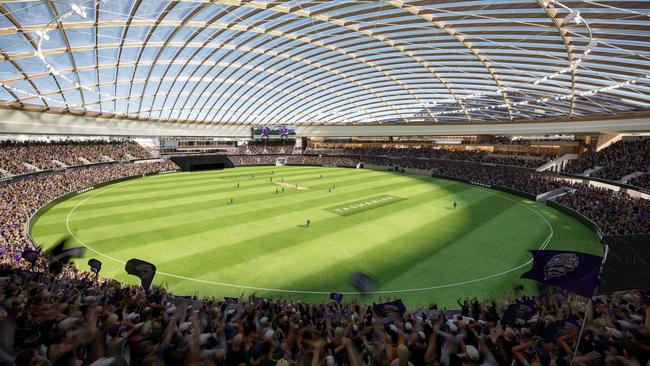Hobart AFL stadium’s $115m blow-out
It will cost more, make a loss and – according to the RSL – diminish a sacred war memorial, but Hobart’s AFL stadium has taken several steps closer to fruition.

Detailed plans for Hobart’s new AFL stadium reveal a cost blowout of up to $115m, multi-million dollar operating losses and visual impacts, but mark a milestone in advancing the project.
Submission of a 269-page plan for the Macquarie Point stadium to the Tasmanian Planning Commission on Wednesday signalled the end of the “phony war” over the stadium – and the start of fierce debate over detail.
The blueprint was immediately criticised by the RSL, which said it confirmed the 54m high stadium would destroy key sightlines of and from the nearby Cenotaph, a “sacred” war memorial.
Its cost – originally estimated at $715m – has officially risen to $775m.
Accounting changes have removed an additional $55m previously included, on the basis that third parties, such as contractors, can be persuaded to fund these costs, or that they are operating expenses.
These include kitchen fit-outs, audiovisual equipment and LED advertising, CCTV and PA systems. If all these costs remained in the build estimate, the stadium would cost $830m.
“This $115 million blowout is … just the tip of the iceberg,” said Greens Treasury spokesman Vica Bayley. “Things are only going to get worse as we move into the construction phase.”
The body charged with delivering the divisive project, the Macquarie Point Development Corporation, suggested the costs could be kept to the original $715m. “We’ll work through a scoping and value management exercise to bring it to budget for delivery,” said MPDC chief executive Anne Beach.
The plan says the stadium “retains the prominence of the Cenotaph by protecting and not obscuring the majority of views to it”, and that the monument would be visible at points from the stadium “seating bowl”.
However, RSL Tasmania chief executive John Hardy told The Australian the plan confirmed the destruction of three historically significant sightlines from the monument: St George’s Church, Hobart’s open spaces and the mouth of the Derwent River.
Mr Hardy said the suggestion the Cenotaph could be viewed from parts of the seating were “belittling” to veterans. “Now we’re paying-per-view to see the Cenotaph?” he said.
“Our members are opposed to this. There’s no reassurance in these documents. The Cenotaph is in its position for its vista. That’s why it was situated there. Its siting reminds everybody of the sacrifices that were and are made.”
A KPMG financial impact report submitted with the plans suggests the stadium would return an average-year operating deficit of $2.14m in real terms, based on a “core scenario”.
The government, which must win parliamentary approval for the stadium, even if receives planning approval, said any cost shortfall would come from the private sector.
Sports and Events Minister Nic Street said the state contribution remained capped at $375m “and not $1 more”. “We are absolutely confident, from the interest that we’ve had, that any shortfall will be covered,” he said.
Premier Jeremy Rockliff, who also announced the Albanese government had backed the plan for the broader Macquarie Point precinct, releasing $240m in federal funds, hailed the progress.
“We are one step closer to turning a wasteland into a hive of economic activity, hosting local, national and international sport, art and events,” he said.
Anti-stadium group Our Place said more cost blowouts would foist debt, service cuts and potentially new taxes on Tasmanians. “The massive stadium debt is only going to get a lot, lot worse and Tasmanians are already paying for it all with worsening health, education and housing outcomes,” said spokesman Roland Browne.








To join the conversation, please log in. Don't have an account? Register
Join the conversation, you are commenting as Logout